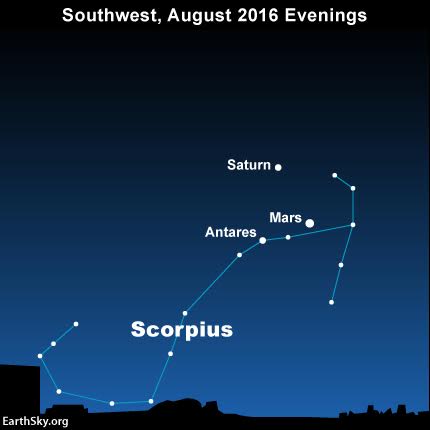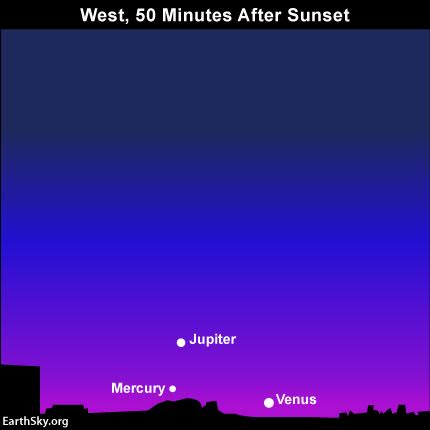Tonight – August 19, 2016 – although it won’t be easy from Earth’s Northern Hemisphere, look for the quasi-conjunction of the planets Mercury and Jupiter. They’ll be at their closest for the month on August 19 or 20, depending on where you are on the globe. Southern Hemisphere viewers see them best, but, for all of us, binoculars will come in handy. The two will be close enough together on the sky’s dome to fit within a single binocular field. So if you see Jupiter, but not Mercury, try reeling Mercury in with binoculars.
No matter where you live worldwide, Mercury and Jupiter will appear in your western sky after sunset throughout August 2016. Moreover, the sky’s brightest planet – Venus – also lights up the western sky, within a stone’s throw of Mercury and Jupiter.
Look westward, starting 45 minutes (or less) after sunset. Mercury and Venus will set less than one hour after sunset at mid-northern latitudes. Jupiter will set around 75 minutes after the sun. Use binoculars to help you out with your planet search, for these bright worlds sit in the glare of evening twilight at northerly latitudes.
If you live in the Southern Hemisphere or the northern tropics, the view of the three planets – Mercury, Venus and Jupiter – improves by leaps and bounds. At more southerly latitudes, the planetary threesome stands higher up in the sky at sunset, and what’s more, these worlds stay out after dark. The Southern Hemisphere has the great big advantage over the Northern Hemisphere for viewing August’s planetary threesome.
Here’s the Southern Hemisphere view …

At the Earth’s equator (0o latitude), Venus sets about 75 minutes after the sun, Mercury sets around 95 minutes after sunset and Jupiter sets over 100 minutes after the sun. Farther south, in the Southern Hemisphere, these planets set even later after sundown. Click here to find out the setting times of the planets in your sky.
Technically speaking, a conjunction of two planets only takes place whenever two planets lie due north and south of another on the sky’s dome. Although Mercury and Jupiter don’t have a conjunction in August 2016, these two worlds do appear less than 5o apart for the next few evenings, showcasing a quasi-conjunction of the planets Mercury and Jupiter.
Bottom line: Find an unobstructed western horizon, and look for the August 19, 2016 quasi-conjunction of Mercury and Jupiter. They’re in the west after sunset. Best of luck!












